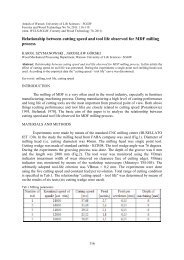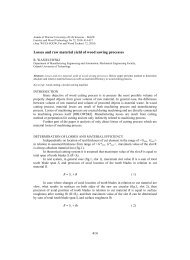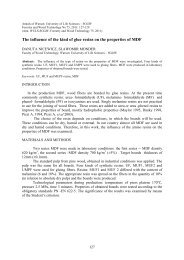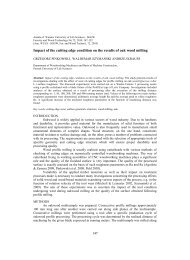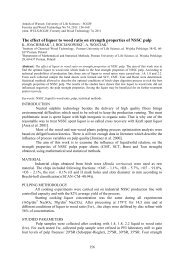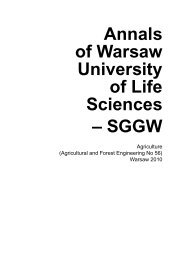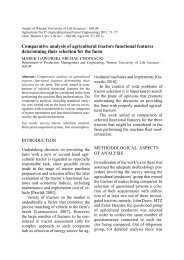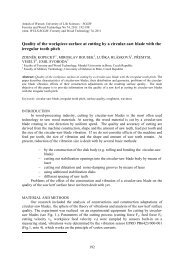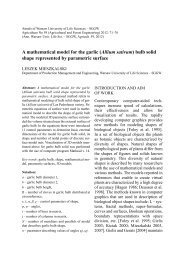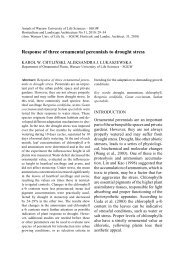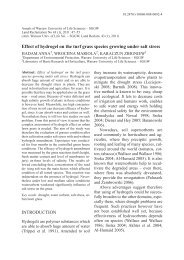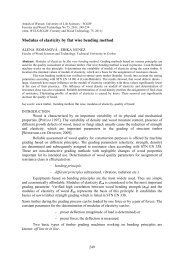Annals of Warsaw University of Life Sciences - SGGW
Annals of Warsaw University of Life Sciences - SGGW
Annals of Warsaw University of Life Sciences - SGGW
You also want an ePaper? Increase the reach of your titles
YUMPU automatically turns print PDFs into web optimized ePapers that Google loves.
within the adhesive network It is assumed that in the first grade <strong>of</strong> degradation N-methylol<br />
groups are dissociated at the end <strong>of</strong> the chain, and later formaldehyde is released from inside<br />
<strong>of</strong> the structure <strong>of</strong> macromolecule.<br />
Perforator method is most <strong>of</strong>ten used laboratory method for determination <strong>of</strong> released<br />
formaldehyde. ROFFAEL et al. (2010) tested samples glued with UF adhesive after<br />
conditioning in the environment with different values humidity. Systematic investigations into<br />
the influence <strong>of</strong> moisture content on the perforator value showed that the relation between<br />
moisture content and perforator values can be represented by a straight line. The emission in<br />
the chamber rose with increasing (measured uncorrected) perforator value.<br />
MATERIAL AND METHODS<br />
In experimental work we tested UF and MUF adhesives and hardener R-60. Natural<br />
polymers were added into adhesives in the form <strong>of</strong> skin collagen hydrolysate (HC). The<br />
hydrolysate was a liquid: collagen amount 26 %, solid content 43 %, pH = 5.2. Hardener was<br />
modified with activator (AG) based on glutaraldehyde (VIPO a.s.). Activator was added into<br />
hardener in amount 1 %, 3 %, or 5 %.<br />
Plywood was pressed from beech or birch veneers; adhesive spread 160 g.m -2 ,<br />
temperature 105 °C (UF), 130 °C (MUF), specific pressure 1.8 MPa, pressing time 5 minutes.<br />
Formaldehyde content determined by FESYP method according to STN EN 120 standard, dry<br />
mater content according to STN EN 322 standard, formaldehyde emission from glued boards<br />
by chamber method according to STN 49 0030 and EN 717-1.<br />
RESULTS AND DISCUSSION<br />
Formaldehyde content in plywood glued with UF and MUF adhesives with modified<br />
hardener (Hr1 and Hr3) are presented in table 1.<br />
Tab. 1 Formaldehyde content in plywood glued with UF and MUF adhesives with AG<br />
Adhesive mixture Requirement <strong>of</strong> the<br />
standard [mg/100g a.d.]<br />
fd content<br />
[mg/100g a.d.]<br />
fd content<br />
relative value [%]<br />
UF + HrR 2.08 100<br />
UF + Hr1 1.90 91<br />
UF + Hr3 8,0<br />
1.98 95<br />
MUF + Hr1 3.14 -<br />
MUF + Hr3<br />
3.89 -<br />
From the obtained results, we can see that AG influences the quality <strong>of</strong> glued joint.<br />
Addition <strong>of</strong> 1 % AG resulted in decrease <strong>of</strong> formaldehyde content by 9 %, the addition 3 %<br />
AG in decrease by 5 %. The situation <strong>of</strong> MUF adhesives is very similar to UF adhesives;<br />
lower content <strong>of</strong> AG caused the lower content <strong>of</strong> formaldehyde.<br />
Further experiments were aimed at research on the influence <strong>of</strong> collagen hydrolysate<br />
on the formaldehyde content in plywood. HC was added into adhesive mixture in the amount<br />
<strong>of</strong> 5 %. The results are given in table 2.<br />
Tab. 2 Formaldehyde content in plywood glued with UF adhesive with AG and HC<br />
Adhesive<br />
mixture<br />
Requirement <strong>of</strong> the<br />
standard [mg/100g a.d.]<br />
fd content<br />
[mg/100g a.d.]<br />
fd content –<br />
relative value [%]<br />
UF+ HrR 2.08 100<br />
UF +Hr1 + 5% HC 1.78 85<br />
UF +Hr3 + 5% HC 8,0<br />
1.54 74<br />
UF +Hr5 + 5% HC<br />
1.89 91<br />
45



